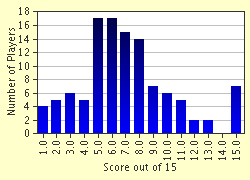Quiz Answer Key and Fun Facts
1. For the most part, what was the Iroquois motivation for war before the arrival of Europeans?
2. In 1608 Samuel de Champlain founded Quebec. This strategic location controlled the St. Lawrence seaway. At the time of Champlain's arrival, conflict between what two Native groups was occurring in the area?
3. In the 1650s, the 5 Nations Iroquois group went on the offensive, raiding French settlements. The type of warfare used by the Native groups was called what by the French?
4. The War of 1812 was fought mostly where?
5. The Riel Rebellion, also known as the Northwest Rebellion, occurred when?
6. Canada became involved in the South African Boer War because:
7. The infamous Sam Hughes, Minister of Militia and Defense under PM Borden, introduced what weapon into the Canadian military (with disastrous consequences for Canadian soldiers during WWI)?
8. The first major battle of WWI that involved Canadian soldiers occurred where?
9. This Canadian military leader lead Canadian victories at Vimy Ridge, Mount Sorrel and Hill 70. He eventually replaced Byng as the Commander of Canadian Corps.
10. May 1917 saw the introduction of conscription in Canada. What is the name of this piece of legislation?
11. This major battle fought by Canadians in World War II involved the use of 6000 men (too small to be a proper invasion, too big to be a raid) of which 900 were killed and 1900 captured:
12. Two Canadian squadrons, the 242 RCAF and 401 RCAF, were involved in the Battle of Britain. What was the name of the German operation to invade Great Britain?
13. The Canadian sector of beach on D-day was called what?
14. The Korean War involved one superpower directly, and another indirectly. This type of war is known as a:
15. The creation of the UNEF (UN Emergency Force) got this Canadian a Nobel Peace Prize:
Source: Author
Leki
This quiz was reviewed by FunTrivia editor
bloomsby before going online.
Any errors found in FunTrivia content are routinely corrected through our feedback system.

